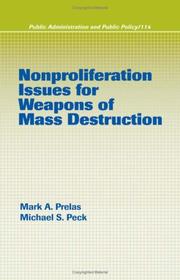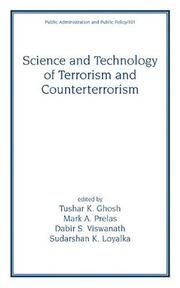| Listing 1 - 8 of 8 |
Sort by
|
Book
ISBN: 9048184940 9048123828 9786613561909 1280383984 9048123836 Year: 2009 Publisher: Dordrecht : Springer Netherlands : Imprint: Springer,
Abstract | Keywords | Export | Availability | Bookmark
 Loading...
Loading...Choose an application
- Reference Manager
- EndNote
- RefWorks (Direct export to RefWorks)
This is a comprehensive book that addresses renewable, non-renewable, and future energy sources and their utilization. All current and potential future energy sources are discussed in great details including the type of energy, methods of converting the energy to useful forms, the engineering design issues associated with the energy conversion system, the efficiency of the conversion process, the economics of the conversion system, the risks associated with its use, the environmental impact and how it can be applied to meet the energy needs of the world. Current and future energy policy is discussed. At the end of most of the chapters there are problems to assist instructors. Also, there are a number of worked out problems for the students within the text. This is the first of a three volume series. In Volume 1, Fundamentals and Nonrenewable Sources, the focus is on the basic tools required to understand the complex interactions of energy and society (economy, population, finance, etc.), fundamentals (thermodynamics, heat transfer, etc.). It provides a general overview of various topics including the interrelationship between energy, economy, gross domestic product, and population. A review of engineering economics, thermodynamics, and heat transfer mechanisms is included. Volume 1 also covers nonrenewable energy resources (coal, oil, natural gas and nuclear); how to calculate the total reserve quantities of coal, petroleum and uranium, and how long these resources will last at various levels of consumption. Various technologies for converting these resources to produce electricity and other forms of energy are treated. The second volume, Renewable and Other Potential Sources, discusses wind, solar, hydropower, geothermal, ocean, biomass, ethanol, fusion, space based power systems, hydrogen, advanced systems and fuel cells. The third volume, Environmental Effects, Remediation, and Policies, looks at the impact of energy on the environment (e.g., acid rain, ozone depletion, global warming, emissions, pollution, etc.), green technologies (e.g., conservation, hybrid cars, electric vehicles, hydrogen economy, distribution systems etc.), policies (e.g., deregulation) and future trends.
Energy policy. --- Power resources. --- Renewable energy sources. --- Power resources --- Renewable energy sources --- Energy policy --- Mechanical Engineering - General --- Industries --- Mechanical Engineering --- Business & Economics --- Engineering & Applied Sciences --- Alternate energy sources --- Alternative energy sources --- Energy sources, Renewable --- Sustainable energy sources --- Energy --- Energy resources --- Power supply --- Energy and state --- State and energy --- Government policy --- Engineering. --- Energy and state. --- Energy industries. --- Energy Economics. --- Energy Policy, Economics and Management. --- Industrial policy --- Energy conservation --- Renewable natural resources --- Agriculture and energy --- Natural resources --- Energy harvesting --- Energy industries
Book
ISBN: 9400714017 9400714025 Year: 2011 Publisher: Dordrecht : Springer Netherlands : Imprint: Springer,
Abstract | Keywords | Export | Availability | Bookmark
 Loading...
Loading...Choose an application
- Reference Manager
- EndNote
- RefWorks (Direct export to RefWorks)
This second volume of Energy Resources and Systems is focused on renewable energy resources. Renewable energy mainly comes from wind, solar, hydropower, geothermal, ocean, bioenergy, ethanol and hydrogen. Each of these energy resources is important and growing. For example, high-head hydroelectric energy is a well established energy resource and already contributes about 20% of the world’s electricity. Some countries have significant high-head resources and produce the bulk of their electrical power by this method. However, the bulk of the world’s high-head hydroelectric resources have not been exploited, particularly by the underdeveloped countries. Low-head hydroelectric is unexploited and has the potential to be a growth area. Wind energy is the fastest growing of the renewable energy resources for the electricity generation. Solar energy is a popular renewable energy resource. Geothermal energy is viable near volcanic areas. Bioenergy and ethanol have grown in recent years primarily due to changes in public policy meant to encourage its usage. Energy policies stimulated the growth of ethanol, for example, with the unintended side effect of rise in food prices. Hydrogen has been pushed as a transportation fuel.
Energy policy. --- Renewable energy sources. --- Business & Economics --- Mechanical Engineering --- Engineering & Applied Sciences --- Mechanical Engineering - General --- Industries --- Energy and state --- Power resources --- State and energy --- Alternate energy sources --- Alternative energy sources --- Energy sources, Renewable --- Sustainable energy sources --- Government policy --- Energy. --- Renewable energy resources. --- Energy and state. --- Alternate energy sources. --- Green energy industries. --- Energy Policy, Economics and Management. --- Renewable and Green Energy. --- Industrial policy --- Energy conservation --- Renewable natural resources --- Agriculture and energy
Digital
ISBN: 9789048123834 Year: 2009 Publisher: Dordrecht Springer Netherlands
Abstract | Keywords | Export | Availability | Bookmark
 Loading...
Loading...Choose an application
- Reference Manager
- EndNote
- RefWorks (Direct export to RefWorks)
Relation between energy and economics --- energie-economie --- hernieuwbare energie
Digital
ISBN: 9789400714021 Year: 2011 Publisher: Dordrecht Springer Netherlands
Abstract | Keywords | Export | Availability | Bookmark
 Loading...
Loading...Choose an application
- Reference Manager
- EndNote
- RefWorks (Direct export to RefWorks)

ISBN: 0824753399 Year: 1977 Publisher: Cleveland CRC Press
Abstract | Keywords | Export | Availability | Bookmark
 Loading...
Loading...Choose an application
- Reference Manager
- EndNote
- RefWorks (Direct export to RefWorks)
Biological arms control --- Chemical arms control --- Nuclear arms control --- Nuclear nonproliferation --- Weapons of mass destruction
Book
ISBN: 9789400714021 9789400714014 Year: 2011 Publisher: Dordrecht Springer Netherlands
Abstract | Keywords | Export | Availability | Bookmark
 Loading...
Loading...Choose an application
- Reference Manager
- EndNote
- RefWorks (Direct export to RefWorks)
This second volume of Energy Resources and Systems is focused on renewable energy resources. Renewable energy mainly comes from wind, solar, hydropower, geothermal, ocean, bioenergy, ethanol and hydrogen. Each of these energy resources is important and growing. For example, high-head hydroelectric energy is a well established energy resource and already contributes about 20% of the world's electricity. Some countries have significant high-head resources and produce the bulk of their electrical power by this method. However, the bulk of the world's high-head hydroelectric resources have not been exploited, particularly by the underdeveloped countries. Low-head hydroelectric is unexploited and has the potential to be a growth area. Wind energy is the fastest growing of the renewable energy resources for the electricity generation. Solar energy is a popular renewable energy resource. Geothermal energy is viable near volcanic areas. Bioenergy and ethanol have grown in recent years primarily due to changes in public policy meant to encourage its usage. Energy policies stimulated the growth of ethanol, for example, with the unintended side effect of rise in food prices. Hydrogen has been pushed as a transportation fuel.
Relation between energy and economics --- Environmental protection. Environmental technology --- duurzame energie --- energie-economie --- hernieuwbare energie --- Power resources --- Renewable energy sources --- Energy policy --- Ressources énergétiques --- Energies renouvelables --- Politique énergétique --- EPUB-LIV-FT LIVINGEN SPRINGER-B
Book
ISBN: 9789048123834 Year: 2009 Publisher: Dordrecht Springer Netherlands
Abstract | Keywords | Export | Availability | Bookmark
 Loading...
Loading...Choose an application
- Reference Manager
- EndNote
- RefWorks (Direct export to RefWorks)
This is a comprehensive book that addresses renewable, non-renewable, and future energy sources and their utilization. All current and potential future energy sources are discussed in great details including the type of energy, methods of converting the energy to useful forms, the engineering design issues associated with the energy conversion system, the efficiency of the conversion process, the economics of the conversion system, the risks associated with its use, the environmental impact and how it can be applied to meet the energy needs of the world. Current and future energy policy is discussed. At the end of most of the chapters there are problems to assist instructors. Also, there are a number of worked out problems for the students within the text. This is the first of a three volume series. In Volume 1, Fundamentals and Nonrenewable Sources, the focus is on the basic tools required to understand the complex interactions of energy and society (economy, population, finance, etc.), fundamentals (thermodynamics, heat transfer, etc.). It provides a general overview of various topics including the interrelationship between energy, economy, gross domestic product, and population. A review of engineering economics, thermodynamics, and heat transfer mechanisms is included. Volume 1 also covers nonrenewable energy resources (coal, oil, natural gas and nuclear); how to calculate the total reserve quantities of coal, petroleum and uranium, and how long these resources will last at various levels of consumption. Various technologies for converting these resources to produce electricity and other forms of energy are treated. The second volume, Renewable and Other Potential Sources, discusses wind, solar, hydropower, geothermal, ocean, biomass, ethanol, fusion, space based power systems, hydrogen, advanced systems and fuel cells. The third volume, Environmental Effects, Remediation, and Policies, looks at the impact of energy on the environment (e.g., acid rain, ozone depletion, global warming, emissions, pollution, etc.), green technologies (e.g., conservation, hybrid cars, electric vehicles, hydrogen economy, distribution systems etc.), policies (e.g., deregulation) and future trends.
Relation between energy and economics --- energie-economie --- hernieuwbare energie

ISBN: 0824708709 Year: 2002 Publisher: New York Dekker
Abstract | Keywords | Export | Availability | Bookmark
 Loading...
Loading...Choose an application
- Reference Manager
- EndNote
- RefWorks (Direct export to RefWorks)
Bioterrorism --- Chemical terrorism --- Nuclear terrorism --- Terrorism --- Technological innovations
| Listing 1 - 8 of 8 |
Sort by
|

 Search
Search Feedback
Feedback About UniCat
About UniCat  Help
Help News
News